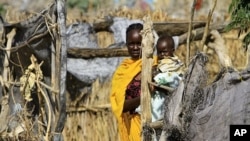The U.N. Security Council meets Tuesday to discuss the principle of protection of civilians in armed conflict. The humanitarian agency Oxfam described the international community’s efforts as “uneven and often biased.”
In a new report, Oxfam looked at 18 armed conflicts that affected civilians last year. It said civilians have paid an unacceptable price in deaths, abductions, displacement and rape.
“Protection of civilians is rooted in international humanitarian law. And it calls upon all actors in a conflict, whether they’re national governments or parties to a conflict, to refrain from excessive force in the conduct of their hostilities and to protect civilians from violence,” said Surendrini Wijeyaratne, Oxfam’s humanitarian policy advisor.
The definition has expanded over the last 15 years to include U.N. peacekeeping missions, mediation and diplomatic missions, as well as humanitarian assistance.
“That came about largely as a consequence of atrocities to civilians in the 1990s in Sierra Leone, in Rwanda and in Bosnia,” she said.
Poor grade
Oxfam’s report, Protection of Civilians 2010, details civilian deaths, rapes and displaced people. It gives a poor grade to the U.N. and the international community.
“If you look at the worst conflicts last year in terms of their impact on civilians,” she said, “Iraq and Pakistan still have the highest number of civilian fatalities. That would be 4,000 in Iraq and about 3,000 in Pakistan. If you look at the worst situations of displacement, we see Sudan, where about 500,000 people were newly displaced both in the north and south last year,” she said.
Sudan also has the “highest level overall of people remaining internally displaced,” with about five million. Oxfam blames that on the continuing political problems and violence in the country, which continues, despite the referendum earlier this year in which the south voted to become an independent nation in the coming months. Darfur, in western Sudan, also continues to be a humanitarian crisis.
In eastern DRC there’s widespread sexual violence,” said Wijeyaratne, “where just in the first six months of last year we saw over 7,000 new incidents of rape and sexual violence. All armed groups in the eastern DRC have been blamed for such attacks, including the Lord’s Resistance Army [LRA], which has its roots in northern Uganda. But it’s now blamed for violence not only in Congo, but also in southern Sudan and Central African Republic.
Wijeyaratne said, “We saw figures of over 300,000 remaining internally displaced due to actions of the group, as well as some 600 abductions. So if you look at those situations, there’s really a very inconsistent response from the international community and the Security Council in particular.”
Don’t forget Somalia
“It’s a war-affected society for decades,” she said. “Last year we saw some 7,600 reporting just weapons-related injuries with Mogadishu alone. It has the highest ratio of internal displacement. Some 16 percent of the entire population of Somalia is displaced. And yet if you look at how the Security Council approaches Somalia, it’s very much focused on issues of piracy and anti-terrorism type measures rather than really looking at the plight of civilians and what can be done to protect them.”
Somalia is also in the midst of a severe drought, contributing to the worsening humanitarian situation.
Security Council
Oxfam wants to see the Security Council take specific actions to improve the protection of civilians in conflict areas.
“First and foremost,” said Wijeyaratne, “the Security Council needs to do much, much better in consistently and fairly responding to crises situations that affect civilians. And more needs to be done to look at situations of crises that are off the council’s agenda, finding innovative ways to look at all situations that are of grave harm to civilians.”
Also, she said the Security Council needs better information on the world’s hot spots and their potential effect on civilians. “There is no ‘one-size-fits-all’ response to protection of civilians in conflict-affected areas,” she added.









